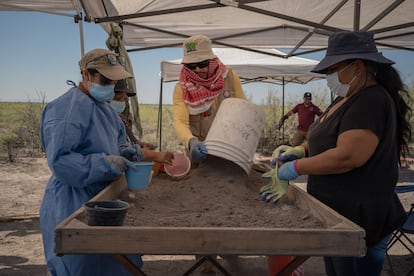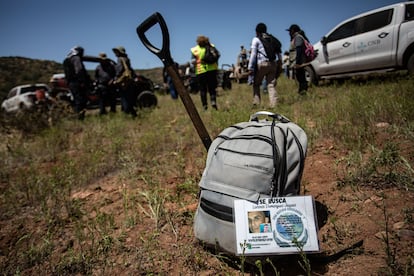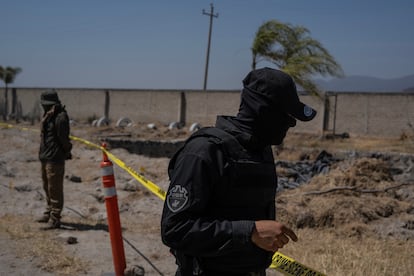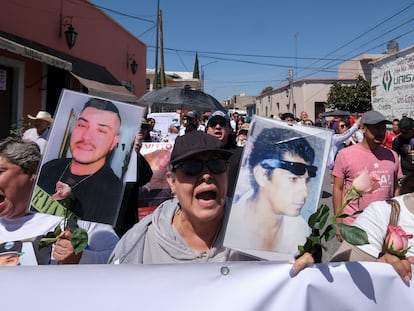The endless horror of Mexico’s clandestine graves: ‘They told us there was one body buried there, and we’re already up to 11’
In less than a week, at least 17 clandestine cemeteries with dozens of human remains have been uncovered in Sinaloa, Baja California Sur and Colima


They arrived, as they usually do, after an anonymous call. Once there, it wasn’t difficult to find the bodies: here a leg sticking out of a pile of dust, there a disembodied hand. Thus, “half-buried,” says María Isabel Cruz, barely having to use a shovel, nine corpses emerged. Dead without a grave or name, abandoned in the Mezquitillo community, an hour from the open-air morgue that the Sinaloa Cartel war has turned Culiacán into. A little scraping of the earth unearthed two more. Some were already bare bones, others were still fresh. The place, “a clandestine cemetery,” had been a dumping ground for years. A random Tuesday morning in Sinaloa: six graves, 11 corpses, and the hope of finding more shreds of life in those holes in the ground.
The hard part was getting there. The Sabuesos Guerreras A.C. collective spent a week on the trail of the Mezquitillo graves, a fitting name for that dusty spot where only mesquite trees grow. “It had already been reported it to the authorities, but you know how it is, the authorities never find anything, and the public just turns to you. An anonymous call reached us a week ago, but we hadn’t gone for safety reasons,” says Cruz, resignedly searching for traces of her son Reyes Yosimar García in the disturbed earth. It took them a while because, if they went alone, no one could guarantee they’d be coming back alive. On Tuesday, they secured support from the army, the police, and the State Search Commission. They didn’t expect to find what they did. “We didn’t know the magnitude of the grave; they only told us there was one body buried there, and we’re already up to 11.”
Over 500 miles south, six more graves filled with human remains appeared in Colima on Monday. The State Attorney General’s Office still doesn’t know how many people it has found: the bodies were so dismembered that only DNA can provide a number. At roughly the same altitude as Culiacán, but on the opposite shore of the Sea of Cortez, seven more graves came to light: five on Sunday, two the day before. Three more remain to be processed, and five bodies have already been exhumed on the outskirts of La Paz, Baja California Sur, says Iris Manríquez, founder of the Búsqueda x La Paz collective. The numbers swell if recent dates are added. On April 13, a grave was found in Tijuana next to an altar of Santa Muerte (Holy Death); days earlier on the outskirts of Hermosillo; at the end of March in Tabasco; that same month in Tamaulipas, and the 72 bodies spread across 38 graves in Chihuahua in January. Local examples of a national horror.

Manríquez tells a story about Baja California Sur that sounds a lot like Cruz’s in Culiacán. The searchers in La Paz had known for years, through anonymous tips, that the ditches along the San Juan de la Costa highway concealed the bodies of missing people. They were even escorted by authorities, who directed them to areas of the highway where nothing ever turned up. “If we said left side, they said right side. Now, with our own investigation, we went kilometer by kilometer, based on anonymous calls that had already come in.” In September of last year, at kilometer four, they found the first bones: 17 people, in 12 different graves. They had been buried there since 2016.
A few months later, this February, they unearthed 22 bodies at kilometer 10. They had been left there in 2018. The ones they found this Sunday, in a spot they prefer not to reveal until the entire area has been processed, were abandoned in 2019: 44 skeletons exhumed in eight months on just one stretch of road. Before that, there were more. In July 2024, 13 bodies were found in 10 graves in Cabo San Lucas. In May, 18 bodies were found in 14 graves in La Paz. And, if Manríquez looks back, she remembers that in 2021 they found three homemade crematoriums in San José del Cabo, surrounded by the remains of 28 people. “Unfortunately, we’ll never know how many people were cremated in those ovens. In a ranch next to them, they found blood, notebooks, and many pieces of clothing belonging to many people.” That same year, north of La Paz, they found another 24 bodies in unmarked graves, this time without human pyres. “Just graves.”
The list has grown over the years, both in Baja California Sur and the rest of the country, but the government has long since given up on its attempts to record the findings, or at least to make them public. The Attorney General’s Office (FGR) should have an updated count of graves with aggregated data from various institutions and search groups, but if one exists, it is unknown. The government’s latest effort in this regard is a map published by the Ministry of the Interior in 2023, which counted 5,698 clandestine graves. At that time, two years ago, that atlas already mapped a country pierced by graves in all four cardinal points. And since then, the clandestine cemeteries, as María Isabel Cruz calls them, have continued to be exhumed.
From Teuchitlán to Mexico
Mexico has turned its attention to clandestine graves and furnaces in the wake of the Teuchitlán case, the discovery in a Jalisco municipality of a ranch where the Jalisco New Generation Cartel tortured, murdered, and disappeared an as yet unknown number of people. As Manríquez lamented about the crematoriums in San José del Cabo, we will likely never know the full extent of what happened within those four walls. “We already lived through it four years ago here, that’s why we believe them [the victims of Teuchitlán], and the government never raised its voice,” the searcher from La Paz complains.
After years of being ignored by the authorities, the La Paz searchers finally got support from the government. They are now accompanied in their searches so they don’t have to venture into cartel territory on their own. “But it’s been hard work, crying, kicking and screaming, telling them to be more humane, to help us more. It was a case of attacking them on social media, telling them they weren’t doing their job, demanding their support, and when they saw that we were locating [graves], they gave in: ‘Instead of creating a political controversy, we’ll help you.’ But authorities come and go, and we’re left with our pain. I’ve been through three different governments, but we are still here in the fight, doing everything to find our families.”

Manríquez decided to found the collective after her sister Elvira Yolanda was kidnapped one night in 2016 by a group of armed, hooded men, who took her away in a white van just a couple of blocks from her home as she returned from gambling at a casino. First, she went to the Prosecutor’s Office, trusting them to do their job. She returned three days after filing the complaint to discover that the commander who had helped her was on vacation and no one was looking into her case. She had to file another report. “We said enough was enough. We started looking for her when we realized the authorities weren’t doing anything, no matter how many clues we gave them. The same authorities threatened us and told us not to look for her.”
She founded the collective and nine years later, around 150 families from the ranks of Búsqueda x La Paz are now chasing the trail left by their loved ones throughout the state. Dozens, maybe hundreds of human bones were found later: “At first, when locations were given, it does make you very sad; you’re not specialized in seeing these kinds of horrendous things. You become tougher, but not in the sense that you stop feeling, but rather you thank God for locating these people, and telling the families that we found them, and they hug you, kiss you, fill you with love, with affection. It takes away all the sorrow that one sometimes sees in a grave. Sometimes you see very ugly things in a grave, which we don’t even mention to the families because it’s pointless. We don’t like finding them that way, but we know we’re bringing peace.”
Sign up for our weekly newsletter to get more English-language news coverage from EL PAÍS USA Edition
Tu suscripción se está usando en otro dispositivo
¿Quieres añadir otro usuario a tu suscripción?
Si continúas leyendo en este dispositivo, no se podrá leer en el otro.
FlechaTu suscripción se está usando en otro dispositivo y solo puedes acceder a EL PAÍS desde un dispositivo a la vez.
Si quieres compartir tu cuenta, cambia tu suscripción a la modalidad Premium, así podrás añadir otro usuario. Cada uno accederá con su propia cuenta de email, lo que os permitirá personalizar vuestra experiencia en EL PAÍS.
¿Tienes una suscripción de empresa? Accede aquí para contratar más cuentas.
En el caso de no saber quién está usando tu cuenta, te recomendamos cambiar tu contraseña aquí.
Si decides continuar compartiendo tu cuenta, este mensaje se mostrará en tu dispositivo y en el de la otra persona que está usando tu cuenta de forma indefinida, afectando a tu experiencia de lectura. Puedes consultar aquí los términos y condiciones de la suscripción digital.
More information
Archived In
Últimas noticias
Chris Martin, Taylor Swift, Elijah Wood and other famous wedding ‘crashers’
‘How does it feel to be a failure?’: Elizabeth Berkley’s journey from ‘Showgirls’ ridicule to vindication
The story of the Málaga virus: The code that haunted Google’s cybersecurity center director for 30 years
The impact of Ecuador’s mega-prison: A polluted river, cleared forests and military checkpoints
Most viewed
- Christian Louboutin: ‘Young people don’t want to be like their parents. And if their parents wear sneakers, they’re going to look for something else’
- The low-cost creative revolution: How technology is making art accessible to everyone
- Liset Menéndez de la Prida, neuroscientist: ‘It’s not normal to constantly seek pleasure; it’s important to be bored, to be calm’
- All the effects of gentrification in one corner of Mexico’s Colonia Roma
- December Social Security and SSI payments: Dates, double checks and the 2026 COLA increase










































